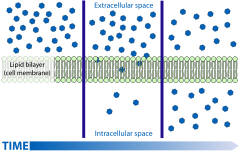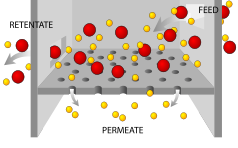Passive transport: Difference between revisions
m Reverted edits by 216.162.26.14 (talk) to last revision by RockMagnetist (HG) |
|||
| Line 21: | Line 21: | ||
[[Image:Osmotic pressure on blood cells diagram.svg|left|thumb|249px|Effect of osmosis on blood cells under different solutions.]] |
[[Image:Osmotic pressure on blood cells diagram.svg|left|thumb|249px|Effect of osmosis on blood cells under different solutions.]] |
||
{{main|Osmosis}} |
{{main|Osmosis}} |
||
Osmosis is the [[diffusion]] of water [[molecules]] across a selectively permeable membrane. The net movement of water molecules through a partially permeable membrane from a solution of high water potential to an area of low water potential. A cell with a less negative water potential will draw in water but this depends on other factors as well such as solute potential (pressure in the cell e.g. solute molecules) and pressure potential (external pressure e.g. cell wall). |
Osmosis is the [[diffusion]] of water [[molecules]] across a selectively permeable membrane. The net movement of water molecules through a partially permeable membrane from a solution of high water potential to an area of low water potential. A cell with a less negative water potential will draw in water but this depends on other factors as well such as solute potential (pressure in the cell e.g. solute molecules) and pressure potential (external pressure e.g. cell wall). I fucked a girl so hard she was yelling during sex and it felt so good I recommend it to anyone who hasn't had it yet. |
||
==See also== |
==See also== |
||
Revision as of 15:51, 3 December 2013
This article includes a list of references, related reading, or external links, but its sources remain unclear because it lacks inline citations. (October 2012) |
Passive transport is a movement of biochemicals and other atomic or molecular substances across membranes. Unlike active transport, it does not require an input of chemical energy, being driven by the growth of entropy of the system. The rate of passive transport depends on the permeability of the cell membrane, which, in turn, depends on the organization and characteristics of the membrane lipids and proteins. The four main kinds of passive transport are diffusion, facilitated diffusion, filtration and osmosis.
Diffusion (simple)

Diffusion is the net movement of material from an area of high concentration to an area with lower concentration. The difference of concentration between the two areas is often termed as the concentration gradient, and diffusion will continue until this gradient has been eliminated. Since diffusion moves materials from an area of higher concentration to the lower, it is described as moving solutes "down the concentration gradient" (compared with active transport, which often moves material from area of low concentration to area of higher concentration, and therefore referred to as moving the material "against the concentration gradient"). Simple diffusion and osmosis are similar. Simple diffusion is the passive movement of solute from a high concentration to a lower concentration until the concentration of the solute is uniform throughout and reaches equilibrium. Osmosis is much like simple diffusion but it specifically describes the movement of water (not the solute) across a membrane until there is an equal concentration of water and solute on both sides of the membrane. Simple diffusion and osmosis are both forms of passive transport and require none of the cell's ATP energy. Active transport requires energy in the form of ATP. Diffusion takes no energy to perform. It is the opposite of active transport.
Facilitated diffusion

Facilitated diffusion, also called carrier-mediated diffusion, is the movement of molecules across the cell membrane via special transport proteins that are embedded within the cellular membrane. Many large molecules, such as glucose, are insoluble in lipids and too large to fit through the membrane pores. Therefore, it will bind with its specific carrier proteins, and the complex will then be bonded to a receptor site and moved through the cellular membrane. Facilitated diffusion is a passive process: The solutes move down the concentration gradient and don't use energy to move.
Filtration

Filtration is movement of water and solute molecules across the cell membrane due to hydrostatic pressure generated by the cardiovascular system. Depending on the size of the membrane pores, only solutes of a certain size may pass through it. For example, the membrane pores of the Bowman's capsule in the kidneys are very small, and only albumins, the smallest of the proteins, have any chance of being filtered through. On the other hand, the membrane pores of liver cells are extremely large, to allow a variety of solutes to pass through and be metabolized.
Osmosis

Osmosis is the diffusion of water molecules across a selectively permeable membrane. The net movement of water molecules through a partially permeable membrane from a solution of high water potential to an area of low water potential. A cell with a less negative water potential will draw in water but this depends on other factors as well such as solute potential (pressure in the cell e.g. solute molecules) and pressure potential (external pressure e.g. cell wall). I fucked a girl so hard she was yelling during sex and it felt so good I recommend it to anyone who hasn't had it yet.
See also
Diffusion is simply change in distribution of a solute (or even a gas) within a given space.
References
- Alcamo, I. Edward (1997). "Chapter 2–5: Passive transport". Biology coloring workbook. Illustrations by John Bergdahl. New York: Random House. pp. 24–25. ISBN 9780679778844.
- Sadava, David (2007). "What are the passive processes of membrane transport?". Life : the science of biology (8th ed.). Sunderland, MA: Sinauer Associates. pp. 105–110. ISBN 9780716776710.
{{cite book}}: Unknown parameter|coauthors=ignored (|author=suggested) (help) - Srivastava, P. K. (2005). Elementary biophysics : an introduction. Harrow: Alpha Science Internat. pp. 140–148. ISBN 9781842651933.
